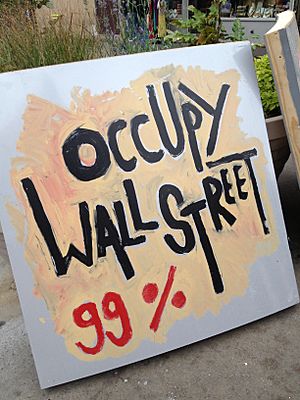Populist Movement facts for kids
The Populist Movement, also known as the People's Party, was an important political movement in the United States during the late 1800s. It grew from groups like the Grange Movement, which helped farmers. This movement was mostly made up of farmers who were struggling financially. They felt that big businesses, especially railroads, were causing their problems.
Leaders of the Populist Movement included Thomas Watson and William Jennings Bryan. The Populists had a list of demands called the Omaha Platform. These demands aimed to help ordinary people, especially farmers, and make the government more fair.
Contents
What the Populists Wanted: The Omaha Platform
The Omaha Platform was a set of ideas that the Populist Party believed in and wanted to make into laws. Here are some of their main goals:
- Fairer Taxes: They wanted an income tax. This means people who earn more money would pay a higher percentage in taxes. Before this, the government mostly got money from taxes on goods, which hurt poorer people more.
- Direct Election of Senators: At the time, U.S. Senators were chosen by state legislatures, not by the people directly. The Populists wanted citizens to vote for their Senators themselves. This would give people more power in government.
- More Money in Circulation: They wanted the government to print more money by using both gold and silver. This was called "free coinage of silver" at a rate of 16 ounces of silver to one ounce of gold. They hoped this would cause inflation, which would make it easier for farmers to pay off their debts.
- Government Control of Big Business: The Populists believed that large companies, like railroads, had too much power and charged unfair prices. They wanted the government to own and control these big businesses. This would ensure they served the public good, not just their own profits.
Impact of the Populist Movement

Even though the Populist Party never gained a lot of power and only controlled a few state governments for a short time, their ideas were very influential. Many of the demands from the Omaha Platform were later adopted by another movement called the Progressive Movement.
For example, the idea of an income tax and the direct election of U.S. Senators eventually became part of the U.S. Constitution. This shows that even if a movement doesn't win elections right away, its ideas can still change society over time. The Populist Movement helped highlight the struggles of farmers and workers and pushed for a more democratic and fair economic system.
Images for kids
-
The Bolivian government of left-wing populist Evo Morales has been described as a key example of ethnopopulism.
-
Protesters from the Tea Party movement, a right-wing populist group in the United States.
-
The Argentine political thinker Ernesto Laclau saw populism as a positive force for change.
-
Nazi Party rally in Nuremberg, 1936.
-
Ilya Repin's painting, Arrest of a Propagandist (1892), showing the arrest of a narodnik.
-
Jean-Marie Le Pen, founder of the French National Front, used populism to gain support.
-
Brazilian President Jair Bolsonaro with US President Donald Trump.
-
Rodrigo Duterte of Philippines and Narendra Modi of India are both considered populist leaders.
See also
 In Spanish: Populismo para niños
In Spanish: Populismo para niños











